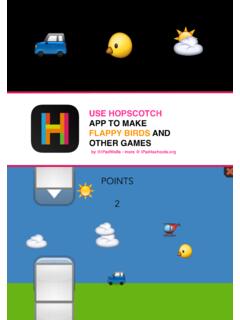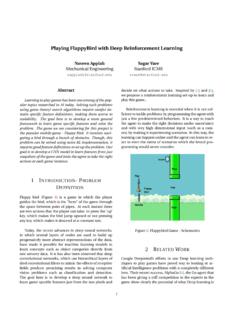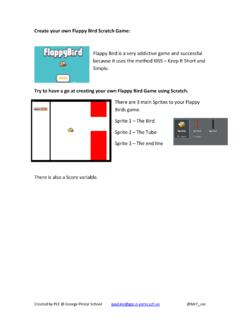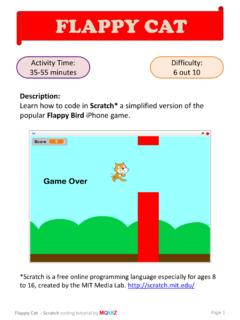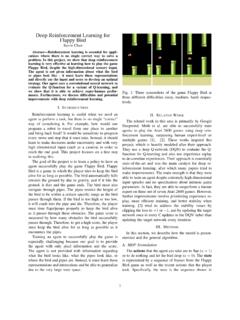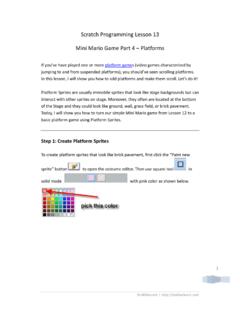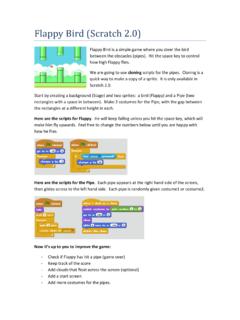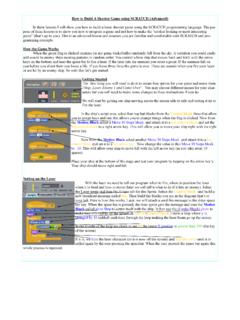Transcription of Exploring Game Space Using Survival Analysis
1 Exploring Game Space Using Survival AnalysisAaron IsaksenDan GopsteinAndy Game Innovation Lab1 ABSTRACTGame designers adjust game parameters to create an optimal ex-perience for players. We call this high-dimensional set of uniquegame variantsgame Space . To help designers explore game spaceand better understand the relationship between design and playerexperience, we present a method to find games of varying diffi-culty. Focusing on a parameterized version of flappy Bird, a pop-ular minimal score-based action game, we predict each variant sdifficulty Using automatic play testing, Monte-Carlo simulation,a player model based on human motor skills (precision, reactiontime, and actions per second), and exponential Survival Analysis ofscore histograms.
2 Our techniques include searching for a specificdifficulty, game Space visualization, and computational creativity tofind interesting variants. We validate our player model with a userstudy, showing it is effective at predicting game modeling, Monte-Carlo simulation, game design, automatedplay testing, dynamic difficulty, game Space , gameplay metrics, Survival Analysis , computational creativity, motor skills, flappy Bird1. INTRODUCTIONAs game designers, we use adjustable game parameters to tunea game to achieve a desirable player experience. Each unique pa-rameter setting creates a new game variant. We refer to this high-dimensional Space of game variants asgame Space . A point ingame Space is a specific vector of game parameters; these settingsdirectly affect the player, enemies, or the level generation [39].
3 Ex-ploring game Space to find specific settings for an optimal experi-ence is a considerable challenge, and we aim to better understandthe relationship between game parameters and player this paper, we examine how game parameters, without chang-ing the game rules, can affect a game s difficulty. For example, wewould expect a variant with fast enemies to be more difficult thanone with slow enemies, even if both versions are otherwise identi-cal and have the same rules. Automatically creating new rules [3, 5,11, 31, 38] is a related problem, but parameters alone have a signif-Figure 1: We explore game Space by simulating game variantsand estimating their difficulty Using Survival impact on game feel [34]: getting Mario s jump to feel rightis more about adjusting parameters than coding accurate set of all game variants for a specific game is high-dimensionaland often impossible to search exhaustively imagine adjustinghundreds of independent control knobs to search for the perfectgame.
4 We reduce the search Space by focusing on game variantsthat only change parameters, not the larger class of variants that in-clude changes to game rules. While tuning games , designers rely onintuition, experience, and user feedback to iteratively search gamespace. The designer must estimate player skill, set game parame-ters, play test, evaluate player experience Using gameplay metrics,revise parameters, and iterate until the game reaches an appropri-ate level of difficulty [7, 9]. When a designer becomes an expertat their own game, they can lose perspective on how their game isexperienced by new players. It can also be difficult for designers tobreak out of local optima and explore creative new regions of gamespace. Automated play testing [20, 47] and visualization [42] helpwith this process, guiding designers in their exploration to creategames best suited to individual skill levels and play styles [10].
5 We present a methodology for tuning game parameters that canbe used by everyday game designers without requiring human Our general approach is shown in Figure 1. To explore anew game variant, we select a parameter vector from a valid rangeof values. Using this vector, we generate a level and simulate play-ing it Using an AI that models human imprecision. We repeat theGenerate and Simulate steps until we have a reliable histogram ofscores for the game variant. We then analyze the histogram usingexponential Survival Analysis [14, 27] to find the decay rate of theexponential distribution. Faster decay predicts a harder game ashigher scores are increasingly less likely than lower our research, we decided to work with a game that is pop-ular and has relatively few adjustable game parameters.
6 We choseFlappy Bird [21] because it is a commercial and critical success,spawning hundreds of similar games , and the rules are simple toimplement and understand. In flappy Bird, a player must fly a con-stantly moving bird without crashing into a series of pipes placedalong the top and bottom of the screen (see Figure 2). Each timethe player taps the screen, the bird flaps its wings, moving upwardin an arc while gravity constantly pulls downward. Each time thebird passes through a pipe gap without crashing, the player scores apoint. Part of the appeal for flappy Bird is the comically high diffi-culty level, especially when typical casual games are easy and for-giving. flappy Bird could have been much easier with a few smalladjustments, such as increasing the gap between pipes or decreas-ing the width of the pipes, but these would have led to different,potentially less rewarding play simulating game play requires an understanding ofhow players react to game events: this is the process of player mod-eling [30].
7 Our player model assumes that much of the difficultyin simple action games is due to human motor skill, specificallyprecision and reaction time [15]. Since we use a static, objective,simulation-based player experience model [46], we do not need toanalyze prerecorded human play sessions of the specific game totrain our player model, and do not rely on live players to estimatethe current level of challenge or fun [8, 12, 16, 22, 36, 47].Our goal is to make the simulator play like a human (novice, av-erage, or skilled), not play with superhuman ability (as might berequired for some parameter settings of Cloudberry Kingdom, agame that exposes its adjustable game parameters to players whengenerating platformer levels [24]). As long as the model properlypredicts human perception of difficulty, it fits our purposes.
8 In min-imal, well-balanced, and compelling action games like flappy Birdor Canabalt [28], the player takes a relatively obvious path, butexecuting that simple path is challenging [19]. In this paper we ex-amine a game with simple path planning and without enemies, sowe can focus on the player s ability to control the game withoutanalytical evaluation of possible player movement [4], multi-factoranalysis of player or enemy strategies [10], dynamic scripting ofopponents [32], building machine learning estimators [36, 29, 45],or evaluating design via heuristics [6].2. GAME SPACEA ction games are defined by rules and parameters, designed toproduce a specific player experience through challenges. Predictingthe qualitative experience is hard, but we can examine the distribu-tion of final scores to predict a quantitative difficulty of the this paper, we refer to this measured difficulty rules are implemented in code and define concepts like ifthe bird collides with the pipe, the game ends.
9 Because we keepthe rules fixed, we can represent our game Space as a high-dimensionalspace over the set of parameters used to tune the have chosen to use the following parameters for our imple-mentation of flappy Bird (see Figure 2). The original flappy Bird,and all our variants, have a constant value for each parameter dur-Figure 2: In flappy Bird, the player must navigate the birdthrough a series of pipes without crashing. We modify the la-beled parameters to generate unique game a play session since the game does not change as the playerprogresses. In general, game parameters can change as the playergets further into a level (for example, in Canabalt the game speedsup as the player progresses) but we did not explore variants withdynamic parameter values as they would require a change in therules that define flappy Separationps More distance between pipes is easier toplay, giving more time to react to changing gap Gappg The distance between the upper pipe and the lowerpipe.
10 Narrower gaps are more difficult as the bird has less room tomaneuver, requiring better motor Widthpw Wider pipes increase difficulty as the bird spendsmore time in the narrow pipe Gap Location Rangelr The pipe gap locations are uni-formly randomly distributed in a range somewhere between theceiling and the floor. Larger ranges are harder because there ismore distance to travel between a high gap and a low Constantg Acceleration of the bird in theydi-rection, subtracted from the bird syvelocity each frame. Highergravity causes the bird to drop faster, lowering the margin of Velocityj When the bird flaps, its vertical velocity is settoj, making it jump upward. Higher velocity makes higher Velocityv Speed at which the bird travels to the right (al-ternately, the speed at which pipes travel to the left).
